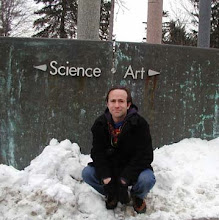I've begun Chapter Two in earnest! Pages are roughed out and starting to assembled finished pages. The first page here is a reworking of a piece i did some time ago called "Mind the Gaps" as a chapter for a book by my advisor Ruth Vinz on narrative inquiry. One side note, in the earlier piece i used the parallax view to show the depth of the Orion constellation. Here because of Perseus' inclusion in the Chapter prior, i figured out the relative distances of the stars in Perseus.
The second page picks up the theme of parallax and connects it to Eratosthene's calculation in which he not only demonstrated the world was not-flat, but also measured its circumference quite elegantly. I was familiar with this method from my dad's physics course, and had wanted to work it in somewhere in the narrative. At some point in playing with ideas, i realized how much it resonated with my working definition of unflattening, and how it could be used to introduce the concept. Anyhow, that's a bit behind the scenes... - Nick




2 comments:
Hey!
I am an avid reader of the website, T&P (and they are actually really big on science, technology, media, and then goes art and occasionally education. They are considered to be a very innovative project in Russia and they always manage to get really prominent scientists and media people to give them an interview, so congrats on this quality journal interview!). Also, I am absolutely amazed by your project!!!While doing research on a non-conventional system of communication myself, I think this is truly amazing that you are writing a dissertation in this form. And the illustrations look absolutely fascinating!!!I hope you will publish your final work, so more audiences will be exposed to this great piece of art and science!I have 3 questions for you:
1. Do you use Illustrator?
2. If you present your research at a scientific conference, do you also demonstrate the comic strips in your PowerPoint or you use a different medium?
3. Was it really not hard to convince your committee to allow you to write a dissertation in this form?
Hi Armadilla,
thanks for your comments and interest in what i'm up to. I'm quite honored T&P reached out to me and offered such thoughtful questions. I do intend to publish this in its entirety when it's finished. In the meantime i'll continue posting excerpts on my site.
To your questions - 1) I don't use illustrator. I draw freehand on an old wacom tablet in photoshop.
2) I've been presenting a lot at conferences and such things in the past year or so, and show slides of my work throughout - never with ppt text though - not a fan of having people read when there's someone there in front of them!
3) It really wasn't that hard to convince my advisors, but mostly because i came in with the thought that i would do this and because i think my advisors quickly saw the potential in this form of expression.
Thanks for the comments - hope you share your research on non-conventional communication... - Nick
Post a Comment